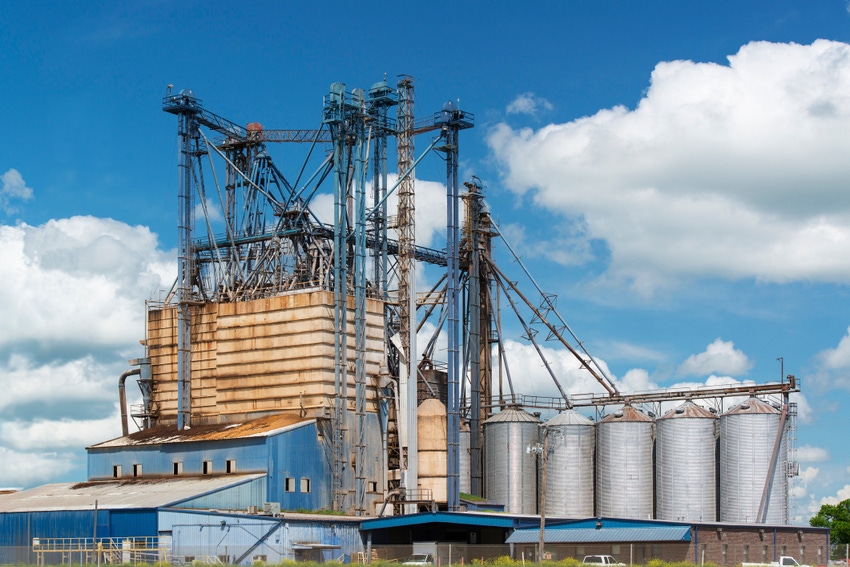Feed industry has evolved and adapted to play an important role in the animal value chain.
September 24, 2021

The majority of poultry meat and egg producers in the United States are vertically integrated. Vertical integration encompasses different segments that are interlinked and often owned by the same company. This article will focus on the poultry industry, but other meat producing industries have similar production models.
Vertical integration has allowed the poultry industry to produce meat and eggs more efficiently, which has resulted in more affordable products to the final customer. The whole structure can be divided into nine segments or levels: primary breeders, feed mills, breeder farms, hatcheries, growout farms, processing plants, further processing, transportation, and marketing.
Feed mills play a very important role in the integrated poultry industry in the United States. As mentioned in previous articles, “feed is typically intended to be fed as a sole source of nutrients.” Feed mills are the “restaurants” and the “foodservice providers” of the poultry value chain. Therefore, correct sampling of incoming ingredients is critical as the nutrient composition of the collected sample is used to make inferences about the quality and nutritional composition of the whole amount of ingredients being received. In addition, the nutritional quality of the raw ingredients should either be preserved or improved (e.g., starch gelatinization, protein gelation) during processing, storage and transportation to fulfill the nutrient requirements of the birds at all times. Furthermore, physical and nutritional segregation should be prevented until the feed reaches the final consumer, the bird.
Integrated feed mills typically produce a limited number of formulas and use a relatively small catalog of ingredients, which reduces hiccups and facilitates the logistics of feed production and delivery. Major ingredients such as corn, soybean meal, DDGS, etc. arrive in bulk trucks and/or rail cars, while minor ingredients (e.g., phosphates, carbonates, and salt) and micro ingredients (e.g., vitamin and mineral premixes, amino acids, enzymes, etc.) may be received either in bulk, bags or totes depending on the total usage level. Ingredients are typically weighed and added into the mixer using a computer automated system. Depending on the market, five formulas are typically used in the production of broilers (pre-starter, starter, grower, finisher, and withdrawal), which helps to increase production efficiency and reduces production costs. Feed is delivered in bulk trucks to breeders and broiler farms. Trucks have a hauling capacity of 24-27 tons and drivers do “loop hauls” where the trucks leave the feed mill full and come back empty, ready to haul the next load to another farm.
The vertical integrator owns the birds as well as the feed mill, feed, delivery trucks, processing plant, etc. Some co-products from the processing plant (chicken frames, feathers, etc.) are purchased by rendering facilities, which transform these raw materials into many useful products such as poultry by-product meal, hydrolyzed feather meal and animal fats, which can then be used as feed ingredients for livestock, poultry, aquaculture, and pet food. The use of co-products from the processing plant to produce high value feed ingredients has increased the sustainability impact of the feed and animal production industries.
In integrated feed mills, all inputs are cost inputs and the only source of income is realized when animals are processed and sold. Therefore, the main objectives are to reduce the cost of production ($/pound of gain) and improve feed efficiency and nutrient digestibility. However, the integrated feed industry understands that investing in feed mill cost centers (e.g., grinding, batching and mixing, pelleting, etc.) is a good approach to reducing production costs, as the majority of feed costs are influenced by the price of ingredients.
Commercial feed mills also play an important role in the poultry value chain. Indeed, in other regions around the globe, the poultry industry is often integrated, but feed mills use the extra production capacity to produce and sell commercial feeds. Commercial feed mills typically have more finished feed bins, have more change-overs between formulations, and own bigger warehouses to store more micro ingredients and bagged feeds. The objective of commercial feed mills is to improve feed quality (typically perceived by the physical attributes of the feed such as pellet quality and feed form, color, smell, etc.) and comply with label guarantees, all while maintaining an acceptable profit. Margins of safety are typically applied to either ingredients or finished feeds. For instance, if the average crude protein of corn is 8.7% and the standard deviation is 0.4, giving a value of 8.5% of crude protein ((8.7 – 0.5(0.4) = 8.5%) ensures that 68% of the time, corn will contain 8.5% or more crude protein. This helps to comply with label guarantees and penalize ingredients with more variation (greater standard deviation of the nutrients’ analysis).
Since the objectives of a commercial and integrated feed mill are somewhat different, feed mill layout and equipment design typically change. Commercial facilities typically use pellet dies with higher compression ratios (relationship between effective pellet die thickness and hole diameter) compared to integrated feed mills. Higher compression ratios typically increase pellet quality but reduces production rate. However, commercial feed mills don’t need to produce as much feed as integrated feed mills, so the payoff can be worthwhile.
Regardless of the purpose, the feed industry has evolved and adapted to play an important role in the animal value chain. Depending on the production goals, new feed mills are being built and equipped with new technologies to control the quality of incoming ingredients (near infrared spectroscopy or NIR), preserve quality during storage (e.g., thermocouples and CO2 sensors), improve pellet quality (double-pass conditioners, post pellet liquid application systems), eliminate potential pathogens present in feed ingredients (Hygienisers), and to automatically control grinding, mixing, pelleting, and cooling operations. These new technologies are helping the feed industry to be more efficient, improve traceability, address food safety, ingredient and feed quality concerns, improve employee safety, and play an even more important role in the animal value chain.
You May Also Like



